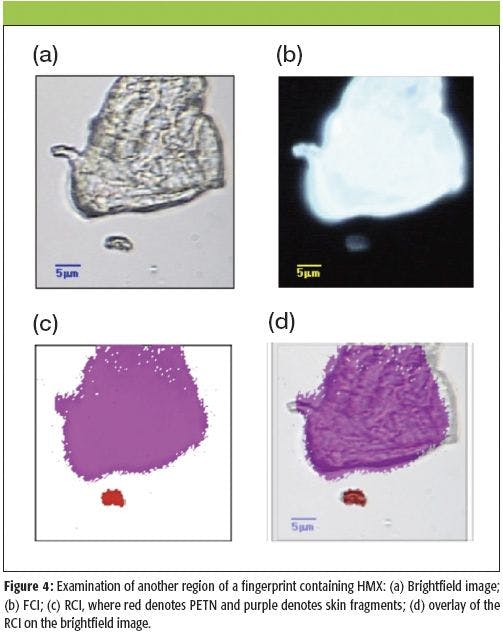Handheld FT-IR and Raman as Tools in the Analysis of Improvised Explosive Materials
Interest in vibrational spectroscopy, principally Raman and mid-IR (FT-IR) continues to increase as these analytical techniques may be applied to a wide variety of fields, including the safety/security sector. Raman and FT-IR have seen rapid deployment for use in homeland security applications, largely due to the high chemical specificity which allows robust identification. In this article, we discuss the application of the latest portable, rugged Raman and FT-IR handhelds, enabling robust identification of explosives, TICs, TIMs, and narcotics in the field. This article introduces explosives, their different classes, and the applicability of Raman and FT-IR spectroscopy to identify their components (commercial, HMEs, and IEDs) or precursors.
Explosives are used around the world for a variety of purposes, including industrial demolition, controlled cutting, earth-moving in construction, explosive charges in airbags, and pyrotechnic bolts and fasteners. Of course explosives are also used as weapons, often as part of military ordnance or, as the public is becoming acutely aware, improvised explosive devices (IEDs) in acts of terrorism.
An explosive is a substance capable of undergoing violent reaction or decomposition to produce heat, gas, and a rapid expansion of matter. For combustion to occur, the material must contain both an oxidizer and a fuel. Explosives can be pure materials containing an oxidizer and fuel in the same molecule (for example, trinitrotoluene), or mixtures of two or more components that are often not explosive in isolation (for example, ammonium nitrate and fuel oil [ANFO]).
Explosives are often categorized with the prefixes high or low depending whether their decomposition or reaction front proceeds faster or slower than the speed of sound: high explosives are said to detonate (supersonic), while low explosives deflagrate (subsonic). The former are capable of performing substantially more "work" for a given quantity of material (generating the most gas, heat, and pressure).
High explosives can be further categorized as either primary or secondary. A primary explosive is an explosive that is extremely sensitive to stimuli such as impact, friction, heat, static electricity, or electromagnetic radiation; correspondingly, a relatively small amount of energy is required for initiation. Secondary explosives are less sensitive to shock, friction, heat, etc. than primary explosives and require substantially more energy to be initiated. Because they are less sensitive and are safer to handle and store, secondary explosives are usable in a wider variety of applications than primary explosives. It should be noted, however, that primary explosives are often used in detonators to trigger larger quantities of less sensitive secondary explosives. Examples of primary and secondary explosives are given in Table I.
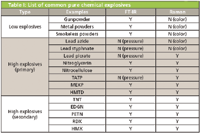
Table I: List of common pure chemical explosives
Conventional Detection of Explosives
A range of technologies has been employed to detect the presence of explosives with moderate to high sensitivity. With all analytical technologies there is an inevitable trade-off between sensitivity, selectivity, portability, and breadth of applicability and explosives detectors are not unique in this regard. Selectivity in portable explosives detectors is usually achieved by quasiselective concentrators or some fast separation technique coupled with a detection scheme. Ion mobility spectrometry, a very common explosives detection technology, is very sensitive to a limited range of explosive materials, but its selectivity remains quite poor making it prone to false alarms. Improvised explosives are particularly challenging for these conventional explosives detectors since such an exceptionally broad range of materials can be used to construct explosive weapons. Tactically speaking, selectivity and breadth of applicability is often more critical than absolute sensitivity with IEDs, making Raman and FT-IR spectroscopy highly suitable for many scenarios.
Portable Raman and FT-IR
Readers of Spectroscopy recognize that Raman and FT-IR spectroscopy have been used in the laboratory for decades in a multitude of applications, the most common being routine material identification and characterization. Over the past five or so years there have been dramatic advances in miniaturized Raman and FT-IR systems, with several commercial systems now offering analytical performance rivalling laboratory units. However, with handheld devices a unique emphasis needs to be placed on interaction design, human factors, ruggedness, and embedded software intelligence to allow nonspecialist users to employ the technology in the field in the analysis of pure and mixed materials with very high reliably and little to no spectroscopic training.
The instrumental attributes of handheld systems are very similar to contemporary laboratory instruments. Ahura Scientific's FirstDefender and TruDefender FT are two such systems.
In the context of explosives identification with FT-IR and Raman, there are several practical aspects that govern applicability. Some materials that cannot be identified by Raman are amenable to identification by FT-IR, and vice versa. For example, some materials can be very difficult to identify with Raman systems due to overwhelming fluorescence. Strongly colored materials are particularly problematic in this regard with 785-nm excitation. Very darkly colored, energetically sensitive materials, such as gun powder, may present an ignition risk when measured by Raman with high power excitation. Fluorescence is obviously not a limitation in FT-IR, nor is there an ignition risk for dark materials, but aqueous samples are difficult to measure with FT-IR due to water interference. Water is rarely an interferent in Raman analysis. Tactically, Raman has the advantage of being noncontact and capable of performing analysis of materials contained in transparent containers such as glass bottles and plastic bags, while FT-IR with an attenuated total reflection (ATR) head requires intimate sample contact, presenting some risk when handling pressure-sensitive energetic materials. Figure 1 shows a Raman spectrum of nitromethane concealed in a dark green wine bottle that is easily identifiable in spite of moderate fluorescence. Although some thick containers can be challenging for Raman, today's Raman devices coupled with the appropriate signal processing often have little difficulty providing unequivocal identification in conditions that have historically been intractable.
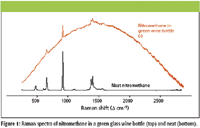
Figure 1
Capabilities
Table I outlines the respective suitability of FT-IR and Raman for the most common pure explosive materials. Likewise, Figure 2 illustrates FT-IR and Raman spectra for several of these materials.
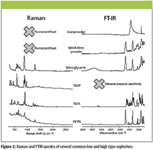
Figure 2
Raman and FT-IR are routinely used for solid and liquid analysis, as discussed in previous sections of this article. While most pure explosives can be measured with either Raman or FT-IR, some materials are better suited for measurement by a particular technique. For reasons of color, FT-IR often performs better for particularly darkly colored materials, such as gun powder and smokeless powders. While better suited toward FT-IR, some of the smokeless gunpowder pellets do require care to measure — the brittle and often slippery pellets can be difficult to crush with an ATR anvil or sample crusher.
While improvised explosives such as TATP, MEKP, and HMTD are all identifiable by Raman and FT-IR, Raman is often preferred due to the pressure sensitivity of these types of materials which make contact and pressure with an ATR problematic. Some materials that are particularly pressure or friction sensitive, such as lead azide and lead picrate, are not well suited to measurement using ATR as noted in Table I.

Table II: Common synthetic agents and mixture components
Identification of pure explosives is certainly an important facet of explosives interdiction, but the identification of explosive precursors and mixture components are equally important. Table II summarizes the applicability of each technique toward common precursors of improvised explosives and Figure 3 highlights spectra for several of these materials.
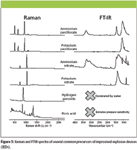
Figure 3
As is the case with finished explosives, precursor materials are often well suited to measurement by both Raman and FT-IR. Raman is a superb tool for the inorganic materials, enabling clear and unique identification of chlorates, chlorites, hypochlorites, chromates, permanganates, and inorganic nitrates prevalent in IEDs. Water-laden samples such as acids and, particularly, hydrogen peroxide are excellent Raman scatterers but are difficult to identify with FT-IR due to heavy interference by water. Materials such as sulfur and phosphorus are often used as sensitizers, and their most active vibrational modes fall below the range often covered by FT-IR. Thus, it is far easier to identify these materials using Raman.
In addition to pure explosives, precursors, and mixture components, it is important to consider finished explosive mixtures. Explosive mixtures are composed of distinct substances and are formulated in varying proportions. Some commercial explosive mixtures include C-4, Semtex, and Detasheet. Many commercial explosives contain plastics and dyes that tend to fluoresce with 785-nm Raman. As such, several of these materials are often more practical to measure with FT-IR. (Figure 4 shows spectra for several commercial mixtures).
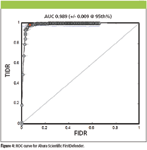
Figure 4
Additional examples of common mixtures, many of which are used in IEDs, and the respective ability of Raman and FT-IR to detect such components are shown in Table III. Information in Table III further illustrates that analysis using both techniques can be highly complementary. For instance, with ANFO or other ammonium nitrate and fuel blends, FT-IR will often easily identify the fuel component and Raman will often most easily identify the ammonium nitrate.
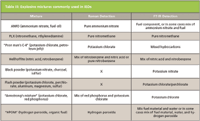
Table III: Explosive mixtures commonly used in IEDs
In summary, as a pair Raman and FT-IR tools provide excellent coverage of the plethora of chemicals found in explosives and used as precursors to make them.
Performance
The ability to collect a Raman or infrared spectrum of an explosive, precursor, or any chemical is only part of the challenge; arguably, the greater challenge is to robustly scrutinize that data and provide the user with decisive information. To understand the applicability of any analytical device in this regard, the receiver operating characteristic (ROC) curve of the system must be characterized. This involves determining the true-identification rate (TIDR) and false-identification rate (FIDR) of the system when it is run by a nonexpert.
The true identification rate (TIDR) is similar to the idea of true positive–alarm rate (TPR) from signal detection theory and sensitivity in clinical diagnostics. This measure summarizes how reliably the device can correctly identify materials that are represented in its library. For any application in which a measure of TIDR is important, a second parameter must also be evaluated: How often does the device suggest a positive identification when in fact the measured material is not represented in the device's library, or how often does it suggest other (incorrect) materials along with a correct material? This false identification rate is related to the false-positive/false-alarm rate (FPR) in signal detection, and the complement of specificity in clinical terminology. The paired terms TIDR/FIDR, TPR/FPR, and sensitivity/specificity are the fundamental components of receiver operator characteristic curves. All of Ahura Scientific's platforms are assessed in this manner so that their performance can be stringently assessed and understood (see Figure 4 for the ROC curve determined for the FirstDefender from reference 2).
Summary
Raman and FT-IR can be utilized by homeland security agencies for the routine identification of a whole range of commercial, homemade, and improvised explosives. Tactically, Raman has the advantage of being noncontact and capable of performing analysis of materials contained in clear and colored transparent and translucent containers. It is also ideal for inorganic materials, enabling clear and unique identification of compounds so prevalent in IEDs.
Improvised explosives such as TATP, MEKP, and HMTD are all identifiable by Raman and FT-IR. Many commercial explosives are routinely identified by both Raman and FT-IR. Where data collection hindrances do occur, such as in Raman from fluorescence caused by dyes or plasticizers, FT-IR is able to collect data underlying the complementary nature of the both techniques.
Finally, both techniques may also be brought to bear on a number of other related applications, they are used by agencies to identify narcotics, suspicious powders and liquids, and chemical warfare agents. Portable Raman and FT-IR can also be used in the pharmaceutical arena for raw material identification and counterfeit detection, providing those in the field with valuable, timely information.
Robert L. Green, Michael D. Hargreaves, and Christopher D. Brown are with Ahura Scientific, Inc., Wilmington, Massachusetts.
References
(1) D. Sword, Homeland Security supplement to Spectroscopy, 16 (April 2009).
(2) C.D. Brown and R.L. Green, Proc. SPIE 6378 637809-1.
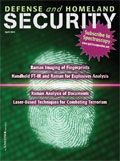
Nanometer-Scale Studies Using Tip Enhanced Raman Spectroscopy
February 8th 2013Volker Deckert, the winner of the 2013 Charles Mann Award, is advancing the use of tip enhanced Raman spectroscopy (TERS) to push the lateral resolution of vibrational spectroscopy well below the Abbe limit, to achieve single-molecule sensitivity. Because the tip can be moved with sub-nanometer precision, structural information with unmatched spatial resolution can be achieved without the need of specific labels.
Tomas Hirschfeld: Prolific Research Chemist, Mentor, Inventor, and Futurist
March 19th 2025In this "Icons of Spectroscopy" column, executive editor Jerome Workman Jr. details how Tomas B. Hirschfeld has made many significant contributions to vibrational spectroscopy and has inspired and mentored many leading scientists of the past several decades.


